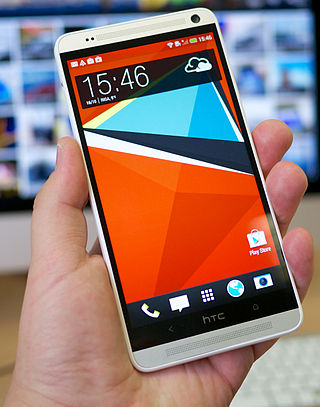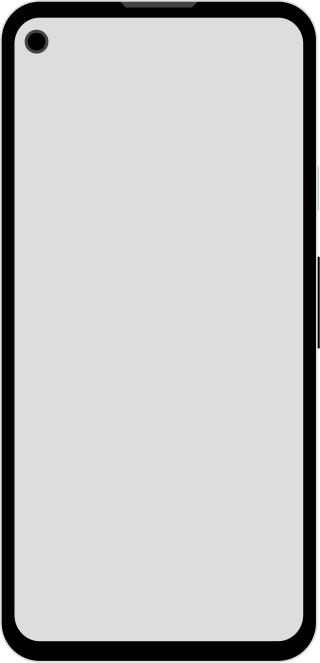Google Nexus is a discontinued line of consumer electronic mobile devices that ran a stock version of the Android operating system. Google managed the design, development, marketing, and support of these devices, but some development and all manufacturing were carried out by partnering with original equipment manufacturers (OEMs). Alongside the main smartphone products, the line also included tablet computers and streaming media players; the Nexus started out in January 2010 and reached its end in October 2016, replaced by Google Pixel family.

The Samsung Galaxy S series is a line of flagship Android smartphones and tablet computers produced by Samsung Electronics. In conjunction with the foldable Galaxy Z series, the lineup serves as Samsung's flagship smartphone lineup, and is the high end line of the wider Samsung Galaxy family of Android devices.
Google Pixel is a brand of portable consumer electronic devices developed by Google that run either ChromeOS or the stock version of the Android operating system. The main line of Pixel products consist of Android-powered smartphones, which have been produced since October 2016 as the replacement of the older Nexus, and of which the Pixel 9, Pixel 9 Pro and Pixel 9 Pro XL are the current models. The Pixel brand also includes laptop and tablet computers, as well as several accessories, and was originally introduced in February 2013 with the Chromebook Pixel.

The HTC One Max is an Android phablet smartphone designed and manufactured by HTC. The device is a larger variant of HTC's 2013 flagship high-end smartphone, the HTC One, notably incorporating a 5.9-inch display and fingerprint recognition features.
The HTC Desire 620 is an Android-based smartphone designed and manufactured by HTC. It is part of the Desire range of mid-range handsets. It was announced on 29 November 2014 in Taiwan. It was announced for the European market on 9 December 2014.
The HTC Desire 300 is a low-end Android smartphone released by HTC in 2013. The phone was announced on 3 September 2013 in London, England. It was stated that the device would be available in October 2013 in select markets.

The HTC 10 is an Android smartphone manufactured and marketed by HTC. It was announced on April 12, 2016.

The LG G6 is an Android smartphone developed by LG Electronics as part of the LG G series. It was announced during Mobile World Congress on February 26, 2017, as the successor to the 2016 LG G5.
The HTC U series is a line of upper mid-range and high-end flagship Android smartphones developed and produced by HTC. The first phones in the series, the HTC U Play and the HTC U Ultra, were announced in January 2017. The HTC U series is the successor of the HTC One series.

The LG V30 is an Android phablet manufactured by LG Electronics as part of the LG V series. Unveiled on 31 August 2017 as the successor to the LG V20, the V30 forgoes the V20's secondary display for a "floating bar" which has nearly the same functions as the second display. It still features quad DACs for improved audio.

Moto X4 is an Android smartphone developed by Motorola Mobility, a subsidiary of Lenovo. Unveiled on August 31, 2017, at IFA, it is a revival of the previously discontinued Moto X line. It was released in Europe at the end of September 2017.
The Pixel 2 and Pixel 2 XL are a pair of Android smartphones designed, developed, and marketed by Google as part of the Google Pixel product line. They collectively serve as the successors to the Pixel and Pixel XL. They were officially announced on October 4, 2017 at the Made by Google event and released in the United States on October 19. On October 9, 2018, they were succeeded by the Pixel 3 and Pixel 3 XL.
The BlackBerry Motion is an Android smartphone manufactured by TCL Corporation under the brand name of BlackBerry Mobile. It was launched on 9 October 2017 in Dubai at the Gitex Technology Week, and first went on sale in the United Arab Emirates and Saudi Arabia on 22 October 2017.
The LG G7 ThinQ, commonly referred to as just LG G7, is an Android smartphone developed by LG Electronics as part of the LG G series. It was officially announced on May 2, 2018, after about a week of official leaks by LG. It is the second product from LG that uses the ThinQ branding. The device serves as the successor to the 2017 LG G6.

The HTC U12+ is an Android smartphone manufactured and sold by HTC as part of the HTC U series. It was announced on 23 May 2018 and succeeds the HTC U11 and HTC U11+ smartphones.
The OnePlus 6T is an Android-based smartphone from OnePlus. It was announced on October 29, 2018, before being released on November 6. The launch was originally scheduled for October 30, but was rescheduled to avoid coinciding with Apple Inc.'s on the same day.

The Pixel 4a and Pixel 4a (5G) are a pair of Android smartphones designed, developed, and marketed by Google as part of the Google Pixel product line. They collectively serve as mid-range variants of the Pixel 4 and Pixel 4 XL. The Pixel 4a was announced on August 3, 2020 via a press release, while the Pixel 4a (5G) was announced on September 30, 2020 at the "Launch Night In" event.

The Pixel 5 is an Android smartphone designed, developed, and marketed by Google as part of the Google Pixel product line. It serves as the successor to the Pixel 4. It was officially announced on September 30, 2020 at the "Launch Night In" event alongside the Pixel 4a (5G) and released in the United States on October 29, 2020. It is a mid-range smartphone in the Pixel lineup that doesn't to feature an XL version. On October 19, 2021, it was succeeded by the Pixel 6 and Pixel 6 Pro.

The Pixel 5a, also known as the Pixel 5a with 5G, is an Android smartphone designed, developed, and marketed by Google as part of the Google Pixel product line. It serves as a mid-range variant of the Pixel 5. It was officially announced on August 17, 2021 via a press release and released on August 26.
HTC Desire 22 Pro is an Android-based smartphone manufactured by HTC. The phone was announced in June 2022.








